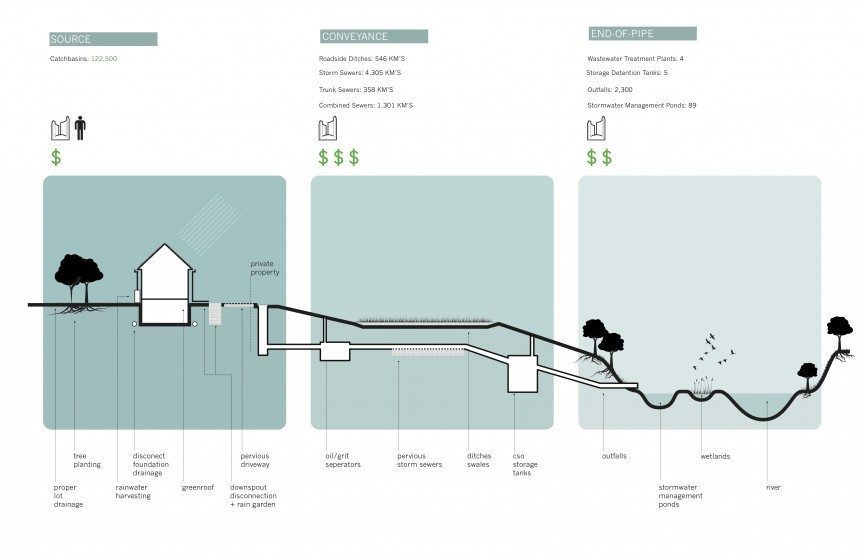As highlighted by The Project's Waleed Aly in a recent piece attacking Herald Sun journalist, Andrew Bolt for his ignorance, climate change can no longer be dismissed as a possibility, opinion or even a theory.
We can no longer ignore climate change. Surely there is no way our political leaders can continue to refute the evidence. And the time to act is now. We talk about resilience theory more and more. It is our cities' ability to respond to the effects of climate change. But simply recovering from disturbances caused by climate change is a reactive response. Nina-Marie Lister (2016) discusses a transition to Proactive Resilience.
Lister describes how despite more than two decades of research, little has been done in the development of policy strategies and design applications for resilience. While extreme weather events including New York's Superstorm Sandy in 2011 and Toronto's ice storm in 2013 has prompted resilience strategies, these have been reactive and rarely continued on into long-term plans once the crisis has subsided. A proactive response involves coordinated urban planning and design for resilience. Resilience must be built into the design of our cities. So what does this look like?
Well, as urbanisation places increasing pressure on our cities, the quality of the infrastructure being built to support it is diminishing. In order for our cities to be resilient, it is most important to never lose sight of the quality of urban planning and built form. After this most essential factor, Lister discusses three approaches to be incorporated in our cities and in our buildings when designing for resilience.
1. Embracing dynamic system change in favour of stability, certainty and predictability. Dynamicity describes a quality which we more familiarly refer to as 'adaptability'.

2. Reintegration of landscape with planning and architecture incorporating coastal management policieis and flood management plans

3. Transformative capacity i.e. shifting our perception of acceptable norms our environments need to bounce back to by building in the ability to change with conditions.

Resilience is an interesting new approach to sustainability and certainly an important consideration not just because it is becoming increasingly relevant with increased frequency and severity of natural disasters but because of its place in responding to war and resource scarcity and financial crises. However, a focus on resilience can sometimes cause a tendency for us to be reactive in our response to sustainability. Resilience-thinking needs to be directed to a proactive approach which equips our cities to avoid the impacts of crisis rather than simply being adequately equipped to recover from crises after they have struck.
Source: Lister, N 2016, 'From Reactive to Proactive Resilience: Designing the New Sustainability', The Nature of Cities, 15 March 2016, accessed 22 April 2016, <http://www.thenatureofcities.com/2016/03/15/from-reactive-to-proactive-resilience-designing-the-new-sustainability/>.
Source: The Climate Council 2016, The Bolt Retort, Facebook page, 7 April 2016, accessed 21 April 2016, <https://www.facebook.com/climatecouncil/videos/784838048319457/>.
We can no longer ignore climate change. Surely there is no way our political leaders can continue to refute the evidence. And the time to act is now. We talk about resilience theory more and more. It is our cities' ability to respond to the effects of climate change. But simply recovering from disturbances caused by climate change is a reactive response. Nina-Marie Lister (2016) discusses a transition to Proactive Resilience.
Lister describes how despite more than two decades of research, little has been done in the development of policy strategies and design applications for resilience. While extreme weather events including New York's Superstorm Sandy in 2011 and Toronto's ice storm in 2013 has prompted resilience strategies, these have been reactive and rarely continued on into long-term plans once the crisis has subsided. A proactive response involves coordinated urban planning and design for resilience. Resilience must be built into the design of our cities. So what does this look like?
Well, as urbanisation places increasing pressure on our cities, the quality of the infrastructure being built to support it is diminishing. In order for our cities to be resilient, it is most important to never lose sight of the quality of urban planning and built form. After this most essential factor, Lister discusses three approaches to be incorporated in our cities and in our buildings when designing for resilience.
1. Embracing dynamic system change in favour of stability, certainty and predictability. Dynamicity describes a quality which we more familiarly refer to as 'adaptability'.

Image: Non linear habitat management: Dynamic uses proposed for Massachussets Military Reservation at various stages of ecoloical succession (Lister 2016)
2. Reintegration of landscape with planning and architecture incorporating coastal management policieis and flood management plans

Image: Toronto's Wet Weather Master Plan, drawn in section to depict implication on landscape infrastructures (Lister 2016).
3. Transformative capacity i.e. shifting our perception of acceptable norms our environments need to bounce back to by building in the ability to change with conditions.

Image: Resilience visualised as a function of the adaptive cycle (Lister 2016)
Resilience is an interesting new approach to sustainability and certainly an important consideration not just because it is becoming increasingly relevant with increased frequency and severity of natural disasters but because of its place in responding to war and resource scarcity and financial crises. However, a focus on resilience can sometimes cause a tendency for us to be reactive in our response to sustainability. Resilience-thinking needs to be directed to a proactive approach which equips our cities to avoid the impacts of crisis rather than simply being adequately equipped to recover from crises after they have struck.
Source: Lister, N 2016, 'From Reactive to Proactive Resilience: Designing the New Sustainability', The Nature of Cities, 15 March 2016, accessed 22 April 2016, <http://www.thenatureofcities.com/2016/03/15/from-reactive-to-proactive-resilience-designing-the-new-sustainability/>.
No comments:
Post a Comment